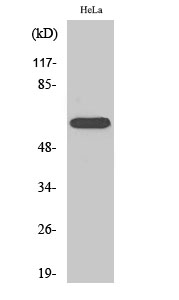RORα Polyclonal Antibody
- Catalog No.:YT4166
- Applications:WB;IHC;IF;ELISA
- Reactivity:Human;Monkey
- Target:
- RORα
- Fields:
- >>Th17 cell differentiation;>>Circadian rhythm;>>Spinocerebellar ataxia;>>Inflammatory bowel disease
- Gene Name:
- RORA
- Protein Name:
- Nuclear receptor ROR-alpha
- Human Gene Id:
- 6095
- Human Swiss Prot No:
- P35398
- Mouse Swiss Prot No:
- P51448
- Immunogen:
- The antiserum was produced against synthesized peptide derived from human RORA. AA range:6-55
- Specificity:
- RORα Polyclonal Antibody detects endogenous levels of RORα protein.
- Formulation:
- Liquid in PBS containing 50% glycerol, 0.5% BSA and 0.02% sodium azide.
- Source:
- Polyclonal, Rabbit,IgG
- Dilution:
- WB 1:500 - 1:2000. IHC 1:100 - 1:300. IF 1:200 - 1:1000. ELISA: 1:40000. Not yet tested in other applications.
- Purification:
- The antibody was affinity-purified from rabbit antiserum by affinity-chromatography using epitope-specific immunogen.
- Concentration:
- 1 mg/ml
- Storage Stability:
- -15°C to -25°C/1 year(Do not lower than -25°C)
- Other Name:
- RORA;NR1F1;RZRA;Nuclear receptor ROR-alpha;Nuclear receptor RZR-alpha;Nuclear receptor subfamily 1 group F member 1;Retinoid-related orphan receptor-alpha
- Observed Band(KD):
- 60kD
- Background:
- The protein encoded by this gene is a member of the NR1 subfamily of nuclear hormone receptors. It can bind as a monomer or as a homodimer to hormone response elements upstream of several genes to enhance the expression of those genes. The encoded protein has been shown to interact with NM23-2, a nucleoside diphosphate kinase involved in organogenesis and differentiation, as well as with NM23-1, the product of a tumor metastasis suppressor candidate gene. Also, it has been shown to aid in the transcriptional regulation of some genes involved in circadian rhythm. Four transcript variants encoding different isoforms have been described for this gene. [provided by RefSeq, Feb 2014],
- Function:
- function:Orphan nuclear receptor. Binds DNA as a monomer to hormone response elements (HRE) containing a single core motif half-site preceded by a short A-T-rich sequence. This isomer binds to the consensus sequence 5'-[AT][TA]A[AT][CGT]TAGGTCA-3'.,similarity:Belongs to the nuclear hormone receptor family.,similarity:Belongs to the nuclear hormone receptor family. NR1 subfamily.,similarity:Contains 1 nuclear receptor DNA-binding domain.,subunit:Monomer.,
- Subcellular Location:
- Nucleus .
- Expression:
- Widely expressed in a number of tissues. Expressed in both regulatory T-cells (Treg) and effector T-cells (Teff) (PubMed:18354202, PubMed:7916608). Isoform 4: Highly expressed in the central nervous system, including in the cerebellum (PubMed:29656859).
The single-cell transcriptomic atlas and RORA-mediated 3D epigenomic remodeling in driving corneal epithelial differentiation Nature Communications Li Mingsen IF Human 1:100 corneal tissue
- June 19-2018
- WESTERN IMMUNOBLOTTING PROTOCOL
- June 19-2018
- IMMUNOHISTOCHEMISTRY-PARAFFIN PROTOCOL
- June 19-2018
- IMMUNOFLUORESCENCE PROTOCOL
- September 08-2020
- FLOW-CYTOMEYRT-PROTOCOL
- May 20-2022
- Cell-Based ELISA│解您多样本WB检测之困扰
- July 13-2018
- CELL-BASED-ELISA-PROTOCOL-FOR-ACETYL-PROTEIN
- July 13-2018
- CELL-BASED-ELISA-PROTOCOL-FOR-PHOSPHO-PROTEIN
- July 13-2018
- Antibody-FAQs
- Products Images

- Western Blot analysis of various cells using RORα Polyclonal Antibody cells nucleus extracted by Minute TM Cytoplasmic and Nuclear Fractionation kit (SC-003,Inventbiotech,MN,USA).

- Immunohistochemistry analysis of paraffin-embedded human breast carcinoma tissue, using RORA Antibody. The picture on the right is blocked with the synthesized peptide.

- Western blot analysis of lysates from HeLa and COS7 cells, using RORA Antibody. The lane on the right is blocked with the synthesized peptide.



